African Guyanese retentions Readingsand handouts Part 5
1. H.V.P. Bronkhurst The Colony of British Guianaand its LabouringPeople
2. Gillian Richards-Greaves Kwe-KweNite:Reinventing'Tradition'forCultural Survival.
3. Eusi Kwayana Buxton-Friendship in Print and Memory
4. Abrams, Ovid Mete Gee:The History and Culture of Guyana
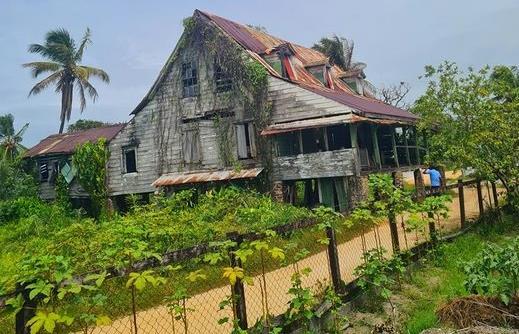

African RetentioninModern Guyana 1) Birth customs
• Condel
• Nine day celebration
2) Marriage customs
• Kwe Kwe
a. Death customs
[In this photograph, dancers in South Africa celebrate the life of the late PresidentNelsonMandela, in dance]
Africans believe that after the death of a person, the soul/ spirit does not leave the earth immediately, although it has separated from the body. Hence, wake is held for at least nine nights, as friends and relatives, stay with the spirit. They play dominoes, reminisce on the life of the departed, acknowledgethe status, and eatfoods such as cook-up. On the day of the funeral, the coffin is danced to the grave. In African-Guyanese villages.
Guyanese villages, these practices have survived.
The religious African groups in the urban areas, such as the Spiritualists or ‘white robed army’, also dance their dead to the grave. This is also practiced in Barbados, by the ‘land ship people’.
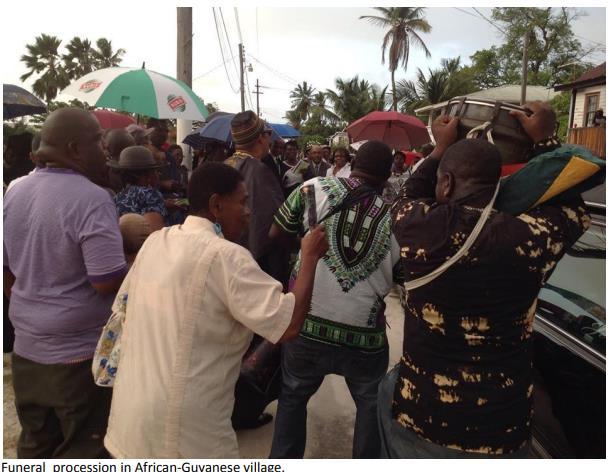
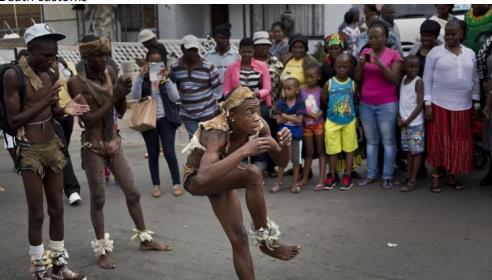
At the graveside, they pourrum, or libation to the dead,
Wake in Guyana. 20 Funeral procession in African-Guyanese village. •
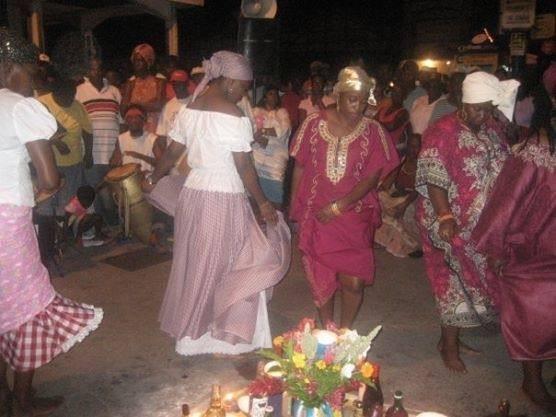
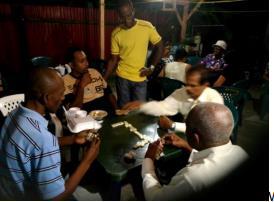

Nine night 3)
Foods • Shine rice • Metem- gee • Cook up rice • Cassavapone • Conkie • Corn pone • Channa/chick peas
• Souse 21 • Mauby • Tamarind drink • Ground nutwine • Gingerbeer • Jamoon wine • Corn wine
4) African sprituality •
Christianity •
Ethiopian Orthodox •
Santeria •
Durrant CleansingRitual
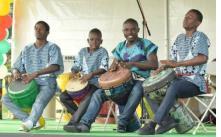
Two women preside over this man's ritual bath on the seawall at kingston, georgetown, guyana, south america. This type of practice is part of the african religious tradition and is known as "spiritual
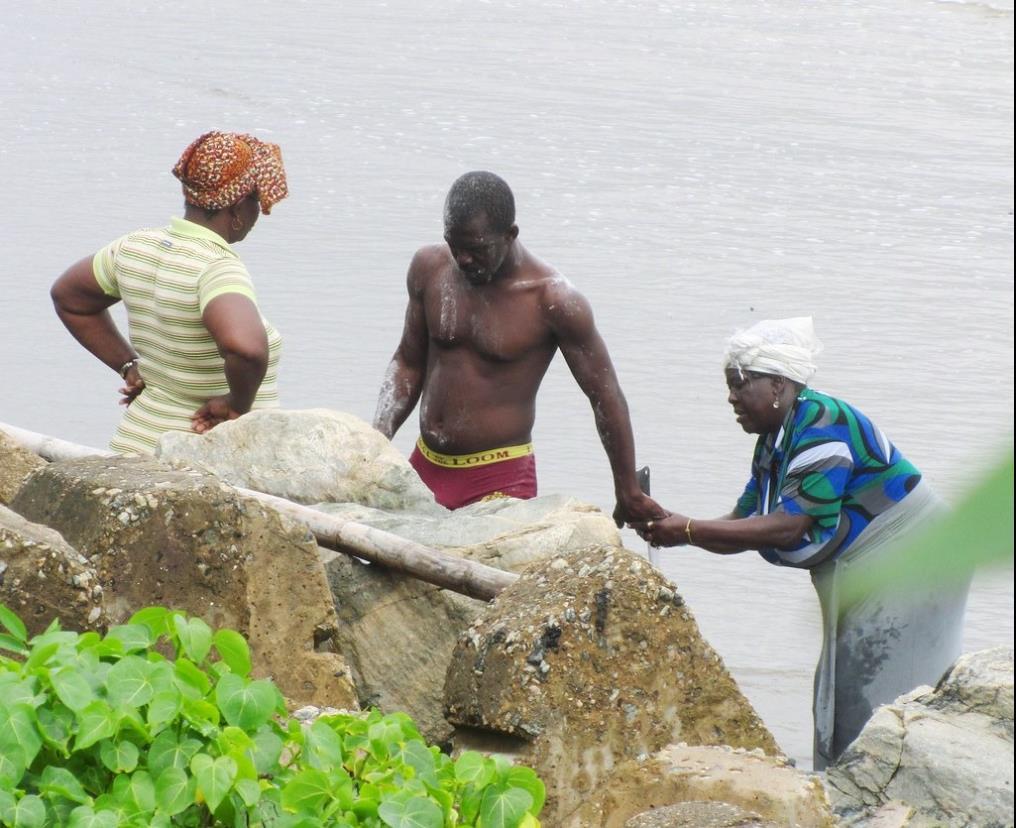
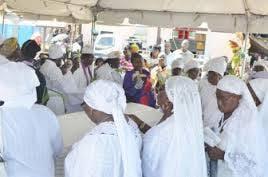
work".these practices are closely related to comfa, which is the principal ritual of a folk religious complex (also called cumfa or cumfo) whose defining elements include ecstatic, trancelike dancing, and spirit possession, induced by drumming. Itis practiced in guyana, south america, mainly by the descendants of enslaved africans. Comfa appears to have evolved from west african sacred performances remembered and reinterpreted by enslaved africans, as they encountered european and asian culture bearers in the new world. According to sociolinguist kean gibson, the foremostexperton guyanese comfa, the religion is currently practiced by about 10 percent of the country’s african-guyanese population.... Cultural historian brian moore [ ] indicates that in postcolonial guyana, the religious practices designated by the term cumfo were also referred to as watermama in honor of the river gods or wind (pronounced wine), in reference to the kind of dancing that reportedly took place during these ceremonies. (taken from: http://www.bookrags.com/.../spirit-possession-dance-in.../)
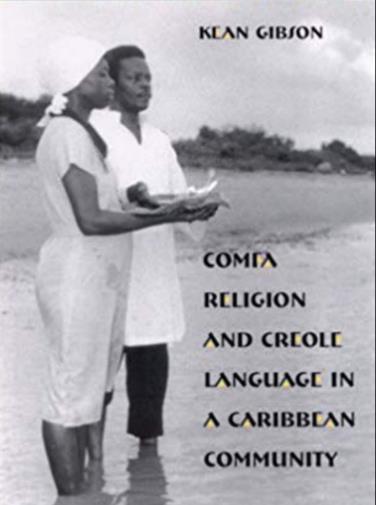
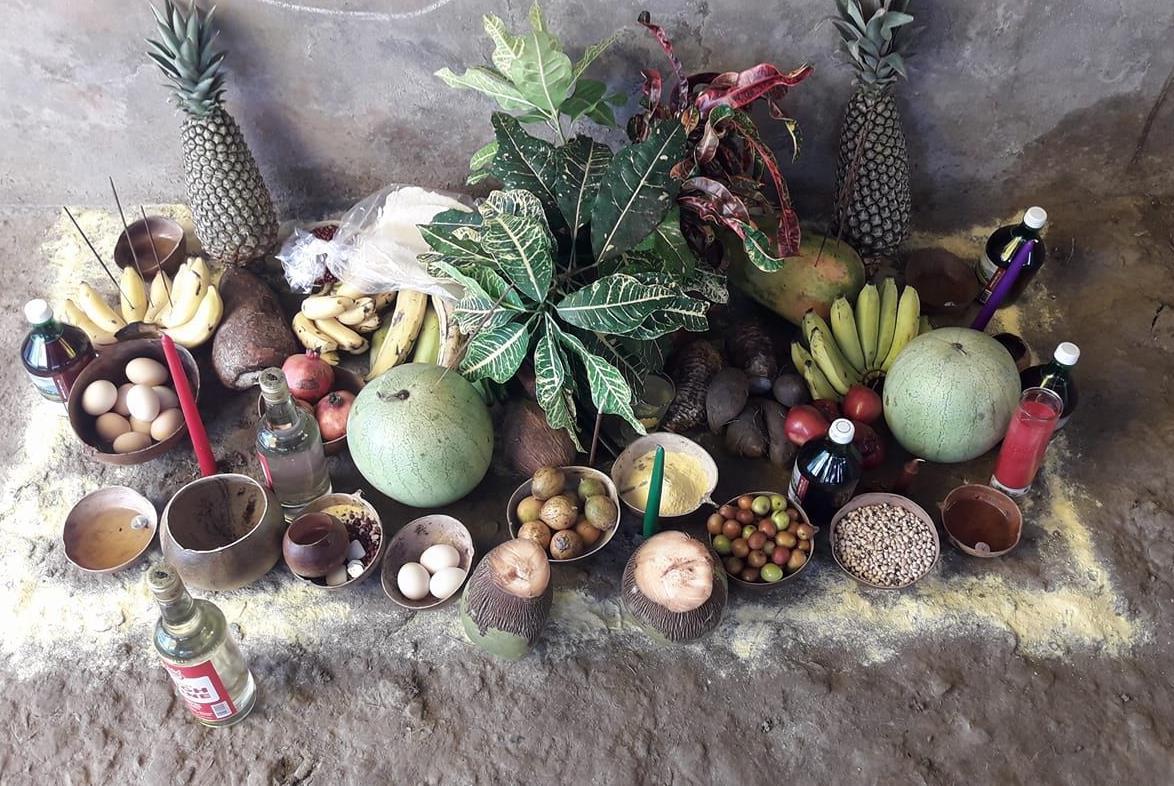
Muslims
Africans in IslamicLands and India
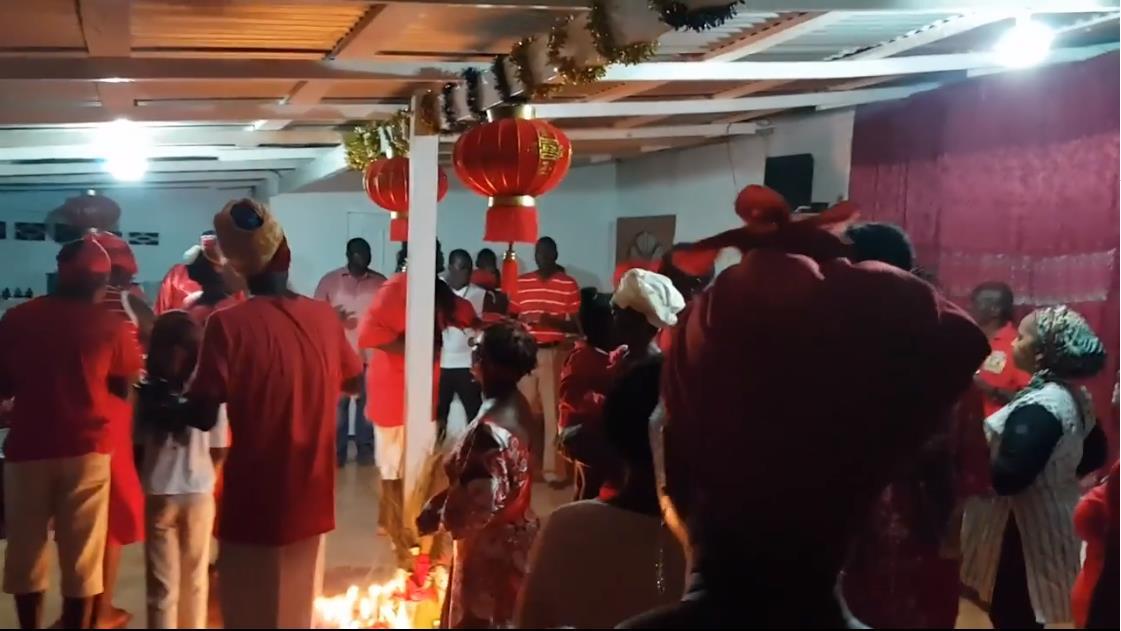
The slave trades were a majorform of migration for Africans, the consideration of which begins with the Islamic lands. While many sub-Saharan Africans would convertto Islam and live as free persons in Islamic
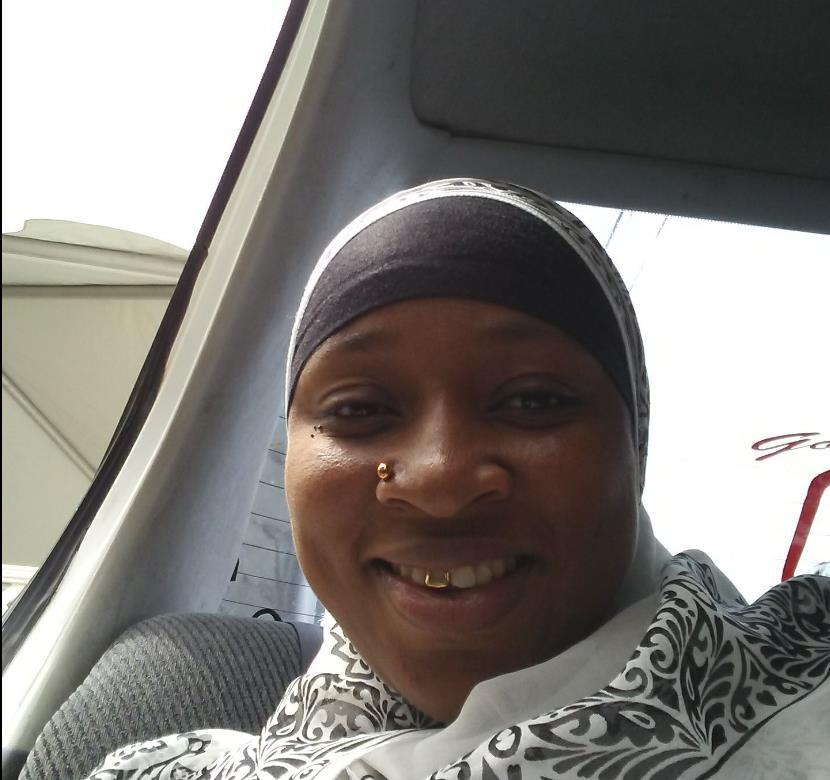
lands, many others entered as slaves. Muslim societies used slaves from all over the reachable world Europeans were justas eligible as Africans, and Slavic and Caucasian populations were the largestsource of slaves forthe Islamic world well into the eighteenth century, especially in the Ottoman Empire. RegardingAfrica, tentative estimates forthe trans-Saharan, Red Sea, and Indian Ocean slave trades are in the range of twelve million individuals from 650 ce to the end of the sixteenth century, and anotherfour million from the seventeenth through the nineteenth centuries. In otherwords, as many or more captive Africans may have been exported through these trades as were shipped across the Atlantic, although the lattertook place within a much more compressed period (thefifteenth through thenineteenth centuries). Such estimates are imprecise, but the number of enslaved Africans in the Islamic world was clearly significant.
The trans-Saharan, Red Sea, and Indian Ocean slave trades were primarily transactions in females and children. Younggirls and women were used as domestics and concubines, and often as both, as the male slaveholderenjoyed the right of sexualaccess. In contrast to the Americas, the children of a slaveholder and a concubine were granted the status of the fatherand became free. Enslaved Africans werealso used in the military, and slave armies were in a number of places in the Islamic world by the ninth century, although most military slaves were non-African. African boys were used as eunuchs, and males were also employed as laborers in large agricultural ventures and mining operations. In addition to the centralIslamic lands, Africans also migrated and made contributions to Iberia(Spain and Portugal), the site of a remarkable Muslim civilization from 711 to 1492. When Muslim forces crossed Gibraltar into Iberia in 711, it was a combined army of Berbers, sub-Saharan Africans, and Arabs. The Almoravids, mostly Berbers with some WestAfrican soldiers (slave and free), seized controlof al-Andalus (Iberia) by the end of the eleventh century. A single African power would control much of North Africa and Iberiafor the nextthree hundred years.
Africans also wentto India. Research on this migration is in its infancy, complicated by an ancientsociety in which the four major castes (Brahman, Kshatriya, Vaishya, and Sudra) are hierarchically arranged in a manner corresponding with color (varna). The lowest, servile caste, the Sudra, is characterized in the ancient Vedic literature as "black" and "dark-complexioned," but as there are many dark-skinned populations throughoutthe world, locating Sudraorigins in Africa is difficult.
Africans traveled to India prior to the rise of Islam in the seventh century, but their presence is better documented with thatreligion's movementinto the subcontinent(as early as 711). Free Africans (as well as non-Africans) operated in Muslim-ruled India as merchants, seafarers, clerics, bodyguards, and even bureaucrats, and enslaved African women and men served as concubinesand soldiers. Called Habshis and Sidis, Africans settled in a variety of locales. Enclaves of Sidis can presently be found in such places as Gujarat (western India), Habshiguda in Hyderabad (central India) and Janjira Island (south of Bombay). There were also anumberof African Muslim rulers duringthe time of the Mughals (1526–1739), and there were atleast severalHabshirulers in the breakaway province of Bengal(eastern India) and in the Deccan. The fate of all these African slaves in the Islamic world is by no means obvious, especially since descent through the free male line obscures, if noterases, African maternalancestry.In Morocco the plightof subSaharan blacks is clearer, as the descendants of slaves, the ḥaraṭīn (called bella further east), were in servile subjection to Arabic- and Berber-speakingmasters. The free descendants of the ḥaraṭīn were also second-class citizens through the nineteenth and into the twentieth centuries. They were heavily dependent upon patron families. One famous community of blacks in Morocco is the Gnawa, noted for their distinct musical traditions. In Morocco, Tunisia, and Algeria, the descendants of sub-Saharan and North Africans practice Islam along with bori, a mix of spirits infants, nature gods, spirits of deceased Muslim leaders, Muslim jinn (spirits), and so on who cause illness and are appeased through offerings, sacrifice, and dance possession.
In India and Pakistan, the descendants of the Habshis and Sidis no longer speak African languages, but their worship, music, and dance are suffused with African content. In addition to those of clear African
descent, there are vast millions descended from intermarriages between Africans and Dalits (formerly called "untouchables") orSudras.
The Jordanites
Filed under: Uncategorized — Bob Wong@ 8:49 pm
by PeterHalderColonial
EraReligion played a fundamentalrole in the British administration of its colony of British Guiana.

It was most probably the policy of the British that in a multiracial country with many races- African, East Indian, Chinese, Portuguese, the indigenous Amerindian, European and their inter-mixtures- and with different cultures and religious practices, the foundation, growth and spread of the Christian religion, could and would convert, indoctrinate, assimilate and unite the many races into a united nation. The colonialists went further. They recognized that the older generation was probably beyond conversion, indoctrination and assimilation, so theirpolicy was to focus on the children, the new generation. Churches dotted the landscape of Georgetown and environs, as wellas the countryside. A schoolsystem was created that welded the schooland church into one unit. For example, the schoolat St. Stephen,Adelaide and Princess Streets was the St.Stephen Church of Scotland School. The school on Smyth Street was the St. Phillips Anglican School. The one at Sussex and Charles Street was the Carmel Roman Catholic School; the one in Kingston was the Kingston Methodist School and at High Street and Brickdam was the St. Andrews Anglican Schooland so on. And as an integral partof the plan, a church was next or near to the school. Children of all races and religions (including Chinese, Hindus and Moslems) attended the school and were required to say a Christian prayer at the beginning and end of the school day and attended church services once a month. The strategy was in full gear until the colony became independent. With independence, church schools came to an end.
Apartfrom the well-known Catholic, Anglican, Methodist, Presbyterian, Episcopalian, Lutheran and other Churches, there were the Jehovah’s Witnesses, Assemblies of God, Pilgrim Holiness, Unity, Seventh Day Adventist and others. Not wishing to seem obvious in their policy, there were also Hindu Temples and Moslem Mosques butthey were faroutnumbered by Christian Churches.
There was also a little known sectcalled the Jordanites, all entirely of the African race. The Jordanites, at least in Georgetown, preached individually, along with a Sister. Those who ministered in Georgetown, preached at street corners or at Bourda Green, opposite the Market, Stabroek Market Square,near La Penitence Marketand near Kitty Market, mostly on Sunday nights. All used the textof the Holy Bible for their sermons but interpreted them in their own way. There was no singing of Hymns at their religious meetings.
“…For many years, members of the Jordanites in their lily white robes and their Leader with a long staff or crook-stick, were a familiar sight in Guyana. They were members of a Church established by Elder Nathanielof Jordan at Agricola, East Bank Demerara. Elder Jordan taughta ‘new doctrine’ (free from the popish traditions and based on principles laid down in the Holy Scriptures contained in the Old and New Testaments) as received from Joseph McLaren of Grenada. Elder Jordan established his Church in 1917 and built the first temple at Agricola in 1924. He was succeeded by ElderJ.N. Klein.
Both men and women dressed in lily white robes, women wearing white bandannas and men wearing white turbans.
Many of their meetings were held nearbusy streetintersections.
Baptisms took place on the beach of the Atlantic Ocean.
They wore no shoes in their Temple, leavingthem outside the door. Many ate no meatat all, others limited the kinds and quantities of meatthey ate.
Jordanites also forbade the use of alcoholic beverages.
The proper name of the Jordanite Church is given as the West Evangelist Millenium Pilgrim Church…” (http://www.encyclopedia.com)
“…And its not only Trinidad and Brazil… argues Raymond Oba Douglas of the Mount Prisgah Spiritual Baptist Archdiocese International Limited. In Guyana, they’re called ‘Jordanites’ because immersion started at the Jordan (River). In St. Vincent they were called ‘Shakers’ and in Jamaica ‘Revivalists.’ But,
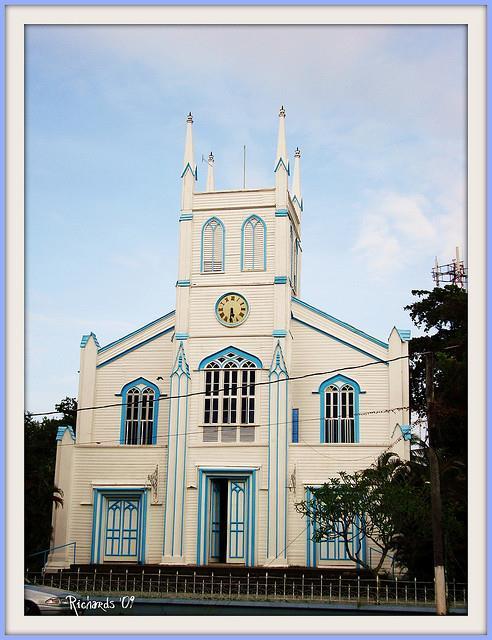
explains Archbishop Douglas, apart from a few differences, they all have the same general trait, ‘entertainment’ of the Holy Spirit, ‘shakings’ and talking in tongues. Itis the Christianity of Africans in the New World…” (Born Again In Living Waters)
It was Sunday nightand the Jordanite preacherwas prepared forhis service. BrotherHezekiah and SisterDeborah were dressed to kill.
The Jordanite was resplendent in a white turban perched securely on top his head, and a long, flowing, lily white robe, held slightly around his waistby a white silk tassel. He had on thick white ‘yachting’ shoes glisteningfrom a coat of Propert’s White Renovator. In his hand, he held a white shepherd’s staff.He was from Agricola on East Bank Demerara. He was tall and lean.
Sister Deborah wore a long, white gown, with a gold coloured tassel tied tightly around her waist,a pair of white Delilah sandals and herhead was covered with a white bandanna.
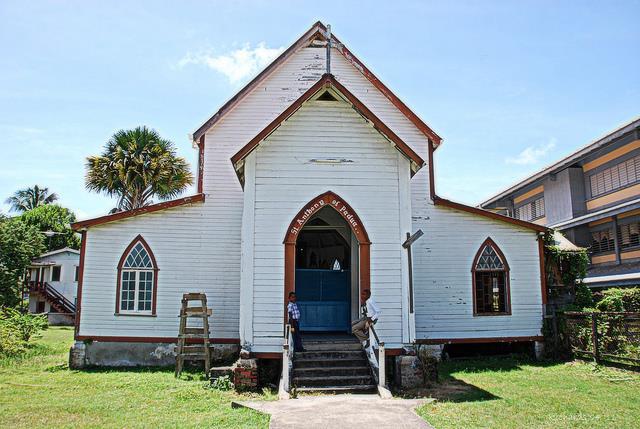
A large, black bottle lamp illuminated the table at which she sat and the surroundingarea. On the table, decorated with a white table cloth, was BrotherHezekiah’s Gold Leaf Bible – the edges of the pages were gold-coloured.
A sizeable crowd slowly gathered atthe venue on the concrete pavementabuttingthe LaPenitence Rum Shop at Saffon and Sussex Streets.
While he waited forthe attendance to increase, he walked up and down, shepherd’sstaff in his righthand and a tibiciri fan in his left. He continuously fanned his face as he walked up and down, chanting“Fan me soldier boy fan me, fan me soldier boy fan me, fan me soldier boy fan me, all me sins done gone.” Gold teeth gleamed in his mouth as he chanted.
His chanting and his strutting around attracted the attention of pedestrians and bicyclists who stopped and joined the gathering.
When he recognized thatthe crowd was large enough and ready to receive his sermon, he walked to the table and put down the fan. He also chose a time when the road traffic along Saffon Street and Sussex Streethad dwindled.
The distinguished-lookingpreacherstrode across the rectangular area, divine and sanctimonious looking but with pomposity, to the edge of the space where there was a white flour bag cloth on the pavement and pointed it out to the people.
“My collection flour cloth that I hope you will make bloom,”he said in slow, precise and solicitous tone of voice, “whosoever will can throw his cent and jill (penny), half-a-bit (six cents), bit (eight cents), bit-nahalf (twelve cents), shilling (twenty-four cents) or florin (forty-eight cents) on it, and if you will, you can have a Thrill on Blueberry Hill and dash down a dollar bill.”
Exuding confidence, he pampazekked to the centre of the area and launched into his sermon where he leftoff the previous week on the eventssurroundingthe Biblicalstory of Lazarus who was raised from the dead.
He reminded his audience aboutLazarus and how fond Jesus was of him. He spoke of how Lazarus loved animals, especially dogs. He told the people “Letme remind you thatthere are animal dogs and there are human dogs.”He evoked aguffaw of laughter.
After about forty minutes into the sermon, he turned to Sister Deborah and told her, “Sister, open that there Gold Leaf Bible and read aloud the verse aboutthe dogand Lazarus.”
Sister Deborah did as ordered. She opened the Bible, pushed it closer to the bottle lamp and read aloud, clearly and distinctly, each word emphasized with driplets of spit, “And moreoverthe doglicked the sores of Lazarus,” she declared, face as serious as a judge but perspiring from the heat of the bottle lamp. She wiped some spit from the side of her lips, using the back of her right hand.
Brother Hezekiah stopped walking. He faced the crowd, raised his staff in the air and shouted out, “You hear that! All you hear that. All you hard ears people hear that! Sister read that verse again so, my flock here tonightcan be filled with the divine words and assimilate and understand them. ”
Sister repeated, taking her time and pausing between each word for emphasis “And moreover the dog licked the sores of Lazarus.”
“All who got ears to hear let him hear and understand. You get it you people? Did you hear clearly and distinctly what Sister Deborah read? Did you hear each individual word clearly? Did you let it sink into your brain? Do you understand what was said? I repeat for your benefit and the glory of God: And moreover the dog licked the sores of Lazarus,” declared the Jordanite Priest in a trumpeting voice but reverently.
Many in the crowd shouted, “Yes we heard. We ain’t deaf. Yes we understand.”
“Let me hear you all together now. May I remind you that this is the Holy Word. Digest it with pleasure like you digest blackpudding, souse, orRussian Bear rum”
All shouted out“Yes, we are with you, ears, heartand soul butdon’ttry to bamboozle or mamaguy we.”
Brother Hezekiah paused to scan the faces of the crowd and the effectof his sermon. He was convinced they were captivated by it and by his oratory in its delivery. Confidently and with intent, he pointed to the crowd and said, “Now I will put what you just said to the test. Tell me you all, tell me, tell me, shout it in my ears, what was the name of the dog that licked the sores of Lazarus?”
Shock and awe enveloped and overpowered the audience.They didn’tknow and failed to appreciatewhat the Priestwas asking them. What did the name of the dog have to do with the story? No one heard any dog’s name mentioned in any case. Deep silence gripped the crowd. You could have cut the silence with a knife.
“Come on, come on all of you. Come on you offspringof Beelzebub, speak up, notshut up. You just told me you heard and you understood whatI and my Sistertook time and greatpains to propound. So tellme
you wise-looking people, what was the name of the dog that licked the sores of Lazarus?” inquired the Preacher.
Complete, absolute and profound silence again greeted the question.
BrotherHezekiah raised his staff in the air, shook it at the crowd and shouted out, ” Oh you hard headed and woe begotten children of this great land, there is none so deaf as he who would not hear. There is none so dumb as he who would notunderstand. There is none so thunderstruck so his tongue is tied. And all you said you all is Christians. Woe is you. A simple divine event like we cited from the Bible many times and you still don’t know the name of the dog even though the Sister read it to you and I repeated it to you!”
Silence continued to prevail.
One small boy in the crowd shouted out, “Well if we deaf and dumb and you is Mr Know All, you tell us the name of the dog since none of us heard any name mentioned.”
Loud cheeringgreeted the challenge.
The Jordanite shifted his eyes to the boy, stared, then smiled and declared, ”There is wisdom in the voice of the youngcrying in this wilderness of silence. So let me read the verse one more time, since from what you justsaid, all you must be have callaloo for brains or your ears have too much bees wax in them. Let me repeatthe Holy text:And moreoverthe doglicked the sores of Lazarus. Itis as plain as the stars in the sky above. Itis as plain as La Penitence Marketbehind you. He thateyes to see lethim see unless he’s got too much booboo in them. The verse clearly states that the name of the dog is ‘moreover’ for it says clearly, precisely and unequivocally ‘And moreoverthe dog…’ meaningthe dog’s nameis “moreover”. The Holy Bible does not make mistakes. And so the wisdom and not a mystery of the Bible is revealed to you all. Blessed are you children of God for receiving his word and glorying in it, no matter whatrace you are. And since the Lord has glorified you for yourpresence here tonight, you must in turn glorify him by your generous money offerings to my ministry. It is more blessed to give than to receive the Bible textsays so I say unto you, you have received wisdom and enlightenment here tonight and you must in return and with gratitude give generously forwhatyou received. You will be blessed when you do.”
Loud cheers and hand claps greeted the Jordanite’s revelation and oratory. Silver coins rained down on the white flourbagcloth and also red one dollar bills. 1.
The Scots Presbyterian Church atChristianburgis the oldestsurviving building in the areaafterthe loss of the Paterson’s homein 2011. Constructed in 1898, this church was attended by mostof the early residents in the area. The timeline would have place this Church witnessing all the significant changes in the Community. The very large Cemetery at the back of the Church was where a large section of the population was interned before the 1943 openingof the nearby ChristianburgCemetery. The openingof the 100 years time vault in 1898 was a first in this Community and reflected the deep roots and appreciation of this special Church. Many historical documents and names of individuals were removed from this time vault that was truly historical and sets a precedentforothers to follow.
Commentby DMITRI ALLICOCK October12, 2011 @ 12:33 pm | Reply 2.
The Seven Days AdventistChurch has its roots in the Milleritte movementof the 1830’s and 1840’s, during the period of the Second Great Awakening and was officially founded in 1863 in the United States Of America. Ellen Gould White (born Harmon) (November26, 1827 – July 16, 1915) was a prolific authorand an American Christian pioneer. She, alongwith otherSabbatarian Adventistleaders, such as Joseph Bates and her husband James White, would form what is now known as the Seventh-day Adventist Church. The Seventh-day Adventist Church formally organized on May 21, 1863 in the United States. The first church and Sabbath School was set up in Guyana in 1887. There was earlier church activity a few years prior. By 1897 in addition to the churches at Georgetown, Botaba and Essequibo there were groups of members in Friendship, East Coast Demerara and New Amsterdam in Berbice.
The Seven Days AdventistChurch willblossom into a very large membership thatwill include many family members. The family members that lived in the riverain areas held church service at their homes. In the early 1960’s my Grandfather’s home at Old England, was used for Sabbath Service. Many of the nearby families would attend. The house would be packed with family members singing while accompanied by the music of the accordion and tambourine. Even though my Grand Fatherand others belongto the Scots Church, they would join in prayers and service. Today the Seven Days AdventistChurch is large and many families are part of its membership.
The Botaba Seven Days Adventist Church of 1897 which is the oldest Seven Days Adventist Church in Guyanastill stands and serves the many families in the area. The Church atYahookathatis located further down river also assists in this manner. There are otherSeven Days AdventistChurches on both shores of the river at Linden.
Commentby DMITRI ALLICOCK October12, 2011 @ 12:42 pm | Reply
African-Guyanese traditions needtobe revivedand cherished – by Murphy Browne
African-Guyanese traditions needtobe revivedand cherished
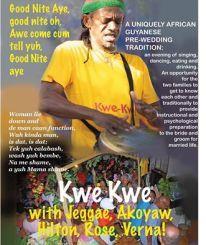 by
by
Murphy Browne – June 27 2012 in SHARE Magazine
Jane engage and she tink nobady like she
Jane engage and she tink nobady like she
Run a kokah dam sometingbruk away
Run a kokah dam
Jane engage and she walk the village wid style
O run a kokah dam sometingbruk away
Run a kokah dam
From Guyanese kwe-kwe song“Jane Engage”
Singing and dancing to kwe-kwe songs is an important part of some African Guyanese pre-wedding celebration. The songs are sungin the Guyanese Creoleselanguage which is derived from severalCentral African and WestAfrican languages combined with thelanguagesof the Europeanswho enslaved Africans. The kwe-kwepre-weddingcelebration does notseem to have a correspondingceremony in any presentday African nation which suggests it was probably derived from a combination of African ceremonies. After all, the Europeans who enslaved Africans went to great pains to ensure that they separated the Africans to make it difficult forcommunication in a common language. The Europeans were afraid that if there were many Africans from any particular nation on their plantation they would fomentrebellion and the Europeans would be caught unprepared. However, African Trinidadian professor, MaureenWarnerLewis, in her 2002 book, “Central Africa in the Caribbean: Transcending Time, Transforming Cultures”,
compares aspects of the Guyanese kwe-kwe to pre-wedding ceremonies in ancient Kongo (Congo.) ProfessorWarner-Lewis who is also the author of the 1999 book, “Trinidad Yoruba: From MotherTongue to Memory”, where she traces remnants of the Yoruba language in Guyana and Trinidad, lists the music and so
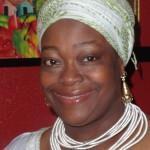
guyanese 9 day baby celebration – guyanese and black babies by caribdirect | Jul 17, 2014 | African Caribbean, AnguillaNews, AntiguaNews, Bahamas News, Barbados News, British Virgin Islands News, Culture & Society, Dominica News, Grenada News, Guyana News, History, How Caribbean R U?, Jamaica News, Lifestyle, Martinique News, Montserrat News, St Vincentand the Grenadines News, St. Kitts & Nevis, St. Lucia News, St. Maarten News, Trinidad News | 0 comments
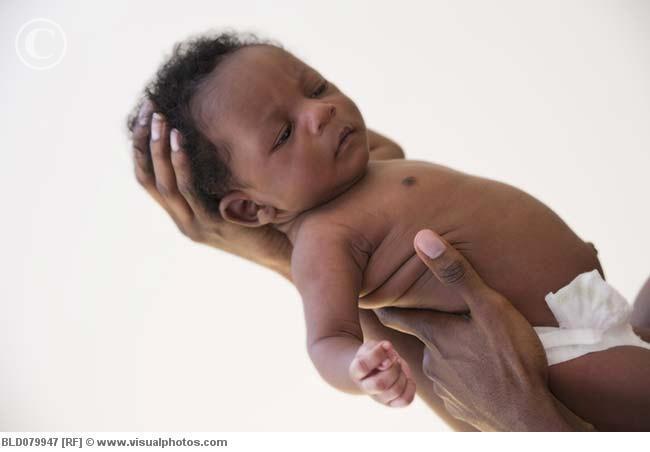
Listen to this article
Social and Cultural Anthropologistand contributor Scherin Barlow-Massay
Community news. When enslaved people were transported to the Caribbean and America’s during the Trans Atlantic Slave Trade, they took with them theircultural beliefs and practices. Various customs that make up the African Guyanese culture have their roots in West African traditions that survived, despite efforts to stamp out all forms of African cultural identity by the enslavers.
Many of those customs survived and passed from generation to generation. One such tradition that survived in Guyana is an after bath exercise and massage regime associated with infants. After a daily bath, the baby is rubbed with olive oil, in preparation for a massage. After this anointing, the mother, or grandmother began a process of exercise movements on the naked infant. The infant’s face is massaged, givingparticular attention to various points on the face includingthe nose. Placed on its back, the baby’s two legs were crossed, and thengently broughtup towardsthe chest, before straighteningitout. The same process is performed on each arm, afterwhich the baby was placed on its belly and the arms broughttowards its back. Then, raising the baby by each arm, it is lifted up and down for a few seconds.
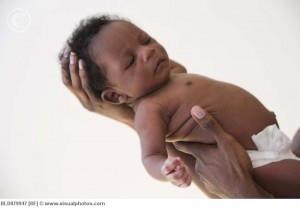
This same lifting process is carried out while holding the infant by the feet. Finally, the infant is thrown into the air and caught. The belief amongAfrican Guyanese is that those procedures are necessary to aid the infant’s physical structure and development, e.g., it would prevent the infant from becoming bowlegged as well as develop its motorskills and help it to become more flexible. Additionally, such exercises were thoughtto improve body circulation.
A motorskill is a movementthatrequires an individualto use its muscle and nerves to make amovement with a part of its body. There are two types of motor skills; gross motor skills are movements a baby makes with his feet, legs, arms or entire body. Such movements allow the baby to lift its head, sit up, crawl, walk and all of the otherskills associated with walking. Fine motorskills include the ability to pick up small objects, tie shoelaces and to write. Unless a child is severely mentally or physically impaired, those milestones are usually indications by which normal developmentis assessed.
Photo courtesy www.brimtime.com
Similar bathing and exercise customs exist today among the Yoruba people from the western part of Nigeria, and the Igbos, from the southeastern partof the country. According to Yoruba tradition, at birth the infantis sprinkled with waterto make it cry. The action of crying ignites the process of breathingby clearing the infant’s mouth, airways and lungs of fluid. Afterwards, the child is carried outside to the backyard, where its umbilical cord is tied and cut. At the spot where the placenta is buried the infant is bathed usinga loofah and rubbed with palm oil. Finally, the newborn is held upside down by its feetand shaken three times. It is the belief that by doing so, it would grow up to be tough and fearless. According to Igbo beliefs, the palm oil was to preventthe baby from having body odours and moulding (shaping) the limbs was to loosen them and make them more agile.
Today, those customs remain more embedded in Igbo culture than in any of the other cultural groups of Nigeria. Those customs became part of the African Guyaneseculturalpractices because large numbers of Igbos were enslaved duringthe Trans Atlantic Slave Trade and taken to the Caribbean and otherparts of North and South America.
EUSI KWAYANA:WRITINGS ANDPUBLICATIONS
(Last updated :April 17, 2007)
Compiled and updated by Nigel Westmaas (this work was first started at Rodney house in Feb 1988 as Research Assistant to Rupert Roopnaraine’s initiative in tracking down accessible writings for Eusi Kwayana in Argosy and Thunder. As Roopnaraine stated at the time in assigning the journey: “I feel in my bones it will be a wonderful voyage. Kwayana’s collected Writings (poems, plays, reviews, screeds, theoreticalexpositions etc) willastonish the world” compilers note:as seen from whence it began, this is ongoing work and is the tip of ‘KaieteurFalls’ so to speak: there is still a lot of material to be collected; assessed, re-arranged; information & dates to be corrected; typos for fixing; chronology to be organized; suitable headings to be prepared; and where possible, annotations. This should, then, like Kaieteur, be treated as work in motion, withoutthe rapids, justthe patient work, and at the end, the grandeurof the size and the range of the content.
Eusi Kwayana:Selected Writings 1947-2006
ART IN REVOLUTION
1. Preface to 1953 Edition of Poems of Resistance
2. Prodigal Daughter(firstplay) Diocesan Youth Movement(circa1940s?)
3. Christus the Messiah – wrote play and lyrics (musicby Cecilene Baird)
4. Lyrics for Songof the theme song“The Song of the DemeraraYouth Rally” (circa 1950s)
5. Foreword to Poems of Resistance from British Guiana, 1954 (Sydney King) in All Are Involve d:The Art of Martin Carter. (StewartBrown Edit. Leeds:PeepalTree Press, 2000.
6. Theatre Reviews by ‘Kiskadee Cloud’ (1960s)
7. Promised Land (prize winning play) 1965
8. “Sydney King welcomes the new GuyanaStar’ the GuyanaStar, March 9, 1966
9. Film Reviews: “The Film as History and a Work of Art” (on the Terror and the Time” 1976) Victor Jara Collective, Georgetown, 1979
10. Cable sentto Co-chair Martin Luther king Day 1981 celebrations – Dayclean, Volv No 13, January 16, 1981
11. “Mediaand Development:the Case of Guyana(LongEssay, 1982)
12. Poem: “When Evil Takes Over”Open Word, No 30, Aug30, 1982
13. Paul Robeson:ConstantStar. WPA booklet, 1988
14. Film Review:“Blessed the Land of Many Mantras”(on MahaShivaRatri:an Experience in Belief, 1987)
15. “Politics of the Heart”: Article Anales delCaribe (Cuba) no. 4/5. 1984/5 (republished in StewartBrown ed All Are Involved:The Artof Martin Carter. Peepal Tree Press, 2000.)
16. “The Poetry of Martin Carter”(long essay, 1986)
17. Preface to Horace Campbell, Rasta and Resistance:From Garvey to Rodney, 1985
18. Eulogy forAunt Augusta(AugustaJulianaMendoncaRead) RC church, Kitty, October31, 1986
19. Preface to Poems (1987)
20. Songs:composed party songs for PNC, PPP & WPA
21. "African -Guyanese Proverbs"in Emancipation No. 2 1994
22. “Lyrics can be Free, YetUnfeeling”Dayclean, March 1-14, 1992
23. “No Bombs on Rodney’s Birthday”Dayclean, Vol. 16, No. 5 Mar 28-Apr 11, 1992
24. “Obituary:Teacher George – End of long Stormy Innings”Dayclean, July 18-Aug 1, 1992
25. “GangGang” : Thirty African Proverbs. Georgetown:Red thread Press, 1997
26. Proclamation (play on 1823 DemeraraRevolt) Dayclean, August 1, 1992
27. Groovy GrammarGeorgetown:Red Thread Press, 1996
28. Statementof Eusi Kwayanaon Mission to Ghana(June 25, 1992)
29. Poem forSydney Browne (lifelongfriend):Reportin Dayclean May 9-23, 1992
30. Eve and the fall of mankind. Stabroek News July 16, 1993
31. Gold Teeth – (play)
32. Messiah (play)
33. King and I (play)
34. Monopoly (shortstory)
35. Satellite (poem)
36. “The LongestRope”(poem)
37. “Weep forBiko” (poem)
38. Poems – (incl. To Dobru; Beverly Jones;Satellite…
39. Whore of Georgetown (poem) n.d
40. “Martin Carter” (n.d)`
41. “Songs of the Folk” Dayclean, June 26, 1995
42. Review of “Themes in African-GuyaneseHistory”Winston McGowan, James Rose, David Grangereds
Georgetown:Free Press, 1998 in Emancipation Magazine 1999-2000
43. "Politics of the Heart"in All Are Involved:The Artof Martin Carter. (StewartBrown Edit. Leeds:Peepal Tree Press, 2000.
44. “African Religious survivals in Guyana”Stabroek News, March 2, 2002
45. “A Friendly, Dream-ful, Dangerous Man: Martin Wylde Carter, or 1927-1997” (first published in the GuyanaReview, Jan, 1998) in StewartBrown, Allare Involved:The Artof Martin CarterLeeds:PeepalTree Press, 2000
46. A review of Judaman Seecoomar's book on Conflict Resolution (December4th. 2002)
47. Review of ‘Voice of the Dragon’ Caribbean Daylight March 28, 2003
48. A review of Review of C. Theresa Heywood "I was there: My Stint in the Guyana National Service"
September21st. 2004
49. Review of Bissundyal’s ‘Jaguarand the Flute’ Stabroek News. July 11, 1993
50. Review : Carmen Subryan, ‘Black Water People’
51. Review of Austin Clarke, ‘The Polished Hoe’ (to check publication)
52. “”Jan Carew: Mission within the Mission” Chicken Bones: Journal for Literary and Artistic AfricanAmerican Themes (nd)
53. ShortEssays on Culture Stabroek News, April131993 “African Guyanese should haveno problem with an Indian monument’ &“Fatherhood of God”
54. Washington poet(Evergreen group) (to check)
55. Review of Lakshmi Persaud, Forthe Love of My Name (Stabroek News?)Date?
56. “Black Jacobins, by CLR James:Revisitingapath-breakingbook,with referenceto othertexts. (Malcom X library e-mailMay 2004)
57. Poem “Songs forthe women”for Rodney Groundings (June 2005)
58. Weep like a Drizzle for Citizen Floyd (Jan 3, 2006) (poem)
59. ArgumentforMale superiority based on Genesis (ShortEssays on Culture No 6)
60. “With all our troubles, is good to see a discussion on Grammar” Letter to Stabroek News, April 17, 2006
61. Poem forMothers : May 14, 2006
62. Review of RupertRoopnaraine’s Primacy of the Eye Bookshelf: guyanacaribbeanpolitics.com (July 21, 2006)
63. Poem forBrotherMalcolm King:For Malcolm, in his Silence. Cotton House FuneralHome. New Jersey, 29 September, 2006
64. Tribute to ‘Saxa Fraser’ of WestCoast Berbice. Dayclean GlobalVol. 1 no. 2 January 2007
POLITICALEXPRESSIONS
1. “Agents for Britain’s Dying Empire” Thunder, Vol. I (September1950)
2. Foreword in FightforFreedom: WaddingtonConstitution Exposed (LegislativeCouncil) by CheddiJagan, January 1952
3. “Observations on Dr. Jagan’s Congress Speech”(1956) University of Puerto Rico
4. Observations on Dr. Jagan’s Congress Speech:to Executive Committee, PPP (Sydney King), 1956
5. “King hits Jagan for Race Prejudice”Daily Chronicle, Jan 21, 1957
6. NextWitness:An Appealto World Opinion first published 1962 by Labour Advocate (republished 1999 with new introduction by the author)
7. 1963: there should not be Independence unless Britain…(n.d)
8. “King Drops Bombshell”Statementon Racial Equality GuyanaChronicle 27, 1961
9. PNC Expelled Me withoutTrial: King GuianaGraphic July 22, 1961
10. “The PPP blundered – says Sydney King”GuianaGraphic, November14, 1965
11. “Glimpses of Kwame Nkrumah’ GuyanaStarMarch 9, 1966
12. “Birth of Freedom”New World. GuyanaIndependence Issue, 1966
13. “Main Job for Guyana’s CentralBank” Sunday Chronicle supplement, October9, 1966
14. Teachings of the Cultural Revolution. Georgetown:ASCRIA, 1968, folleto
15. “Shootingcannot help our People”Sunday Graphic, January 2, 1972
16. “The True Revolution”, Sunday Graphic, January 28, 1973
17. Aspects of Pseudo-Socialism in Guyana(1976)
18. “Two GreatHistorical Experiences”Sunday Chronicle RepublicIssue, Feb 22, 1970
19. “Birth of Freedom”Sunday Chronicle RepublicIssue, Feb 22, 1970
20. Guyanaand the Cuban Revolution_____________ (1970s)
21. “Those Who Take up the Gun Will surely Perish by the Gun”Sunday Graphic, Oct 10, 1971
22. “Kwayana: PM being‘messed up’”, GuianaGraphic, May 7, 1971
23. ASCRIA chides Dr. Lewis on black PowerIssue – Eusi KwayanaSunday Graphic, Dec 19, 1971
24. The Bauxite Workers Strike and the Old Politics (booklet) Georgetown:Bovell’s Printery, 1972
25. “stop paying SPA for Land” Weekend Post&Sunday Argosy, Dec10, 1972
26. “The True Revolution”Sunday Graphic Jan 28, 1973
27. “On Pseudo-Socialism and the PNC”(longessay, 1973)
28. “On Guyana’s code of Conduct” – interview in Caribbean Contact, March 1976
29. “Racial Insecurity and the Old Politics” (longessay, 1975)
30. “Guyana’s Politics: Guyanaand the Cuban Revolution”(Buxton, 1975)
31. Chairman, Soweto Public Meeting:St. Georges Schoolroom, Sunday, June 26_____Speakers DrFranz Lee & Dr. CheddiJagan
32. Letter to Eusi Kwayana from Arnold Rampersaud, political prisoner in the Georgetown Jail. June 3, 1977
33. Racial Insecurity and the Political System (speech):Georgetown:August1978
34. “Eusi Answers Burnham’s Lies”Press Release February 6, 1980 in Dayclean Feb 8, 1980
35. “Walter Rodney Lives: An analysis of Walter Rodney’s Contribution to National and International Struggle for Bread and Justice” in Sign of the Times (booklet) 1981
36. Cable sent to Martin Luther King Day Celebrations (USA) following invitation to co-chair event. Dayclean vol V no 13, January 16, 1981
37. Letterto US Charge D’ Affaires on US Special Report90 statementon WPA. December11, 1981
38. Follow up letter to US charge D’ Affaires onus specialReport90 January 22, 1982.
39. Furtherletterto US charge D’ Affaires on US special Report90 January 26, 1982.
40. ‘The US Card in Venezuela Guyana Land Row“, : Caribbean Contact (Bridgetown, Barbados), March
1982
41. Dayclean Special:“Who Can Libel Burnham?”(1982)
42. Letteron ‘Right to Work Association’ in Open Word October11, 1982
43. Address to PNP’s 44th Annualconference forWPA:Dayclean VolVII No 41 Sept25, 1982
44. “The New Froudacity:On Comrade Pavlovski”Dayclean (1983)
45. Taking control of the Media. (Mimeo) Georgetown:1983
46. Eusi KwayanaReplies to Sick SheetDayclean January 8, 1983
47. Grenadaand The Caribbean (WPA March 13, 1984)
48. KwayanaSpeaks to GuyanaDayclean, December5, 1985
49. Forward to the DemocraticRepublic(Presentation madeby EusiKwayanaand publishedand endorsed by WPA Critchlow Labour college, 1985)
50. Walter Rodney, (Booklet, 1985)
51. SI article: GuyanaAfterthe Death of Burnham. (1985)
52. Socialist Guyana – the Way Forward and Upward. Georgetown, 1985
53. Second Election Broadcast, 1985
54. “Robbed at Gunpoint”Caribbean Contact, March 1986
55. “A slight correction”: letterto PH Daly Open Word, Jan 27, 1986
56. Speech:‘Future of the Caribbean’ Soweto Anniversary Rally – Brooklyn, June-July 1986
57. ‘Public Notice’ on Estimates Violation – Open Word, August11, 1986
58. “Message from the Fast”(sentout Day 5 of the Fast) Dayclean Vol 11, No. 23, 1987
59. “Race in the GuyanaRevolution”(long essay, 1987)
60. Letterto Ministeron Old Age Pensions Dayclean June 6, 1987
61. Crisi Continues: message from the Faston Electricity Open Word, No 291. Nov 9, 1987
62. “Forgive them their panic” (on fast) Open Word No. 292 (November16, 1987)
63. “My pen will not sleep”Open Word No. 292 (November16, 1987)
64. WPA Cables Compton signed by WPA MP KwayanaOpen Word, No. 297, Dec21, 1987
65. “Footnotes to the Weston Trial” (longessay, 1988)
66. WPA MP letterto Ministry of Trade : “Flour Questioned”Open Word, Feb 29.1988 No. 306
67. Personalstatementto Press and Public (decision to join in fastfor Ramadan) WPA Press release April 16, 1988
68. MP letter to Deputy Prime Ministeron GRC incinerator : WPA Press release, May 10, 1988
69. The Great Peanut Rip-off: Release of WPA MP letter (15th June) to the press- Open Word, Sept 12, 1988 No. 333
70. Letters from WPA MP on Occupation of the Office of the Elections Commission by the government Whip (February 27, 1989) WPA Press Release, February, 1989
71. WPA MP Letterto VP of Culture and socialDevelopmenton managementof SocialImpactprogramme. WPA Press Release March 23, 1989
72. The Public should Know (Handbill on Kofi) Apr18, 1989
73. WPA MP Memorandum for Delegates to the conference of the Caribbean, the Americas and the Atlantic Region of the Commonwealth Parliamentary Association - May 31, 1989
74. Parliamentary Submissions:April - October, 1953/ Jan 1986- 1990?
75. Interview:“1953: Nobody was sayingSocialism Could be Introduced”Stabroek News, May 29, 1989
76. Copy:lettersentto Prime MinisterMargaretThatcher from WPA MP Eusi Kwayana, May 10, 1989
77. The Public should Know (Handbill on Kofi) Apr18, 1989
78. WPA MP letteron Electricity Situation to Leaderof the house. WPA press release Sept27, 1989
79. Letterby WPA MP on East Bank Essequibo disaster:WPA Press Release, Oct15, 1989
80. Letterto IADB: WPA Press release, Dec15, 1989
81. Letterto IADBas WPA MP:WPA press release, Jan 5, 1990
82. WPA MP: Letterto Barge Committee of Enquiry: March 16, 1990
83. Personalstatementto Press:April 16, 1990
84. WPA writes Ombudsman on City Council’s failure to do its duty:Sept5, 1990
85. WPA MP to ombudsman on Georgetown’s :Sept5, 1990
86. WPA MP: Recommendation to NationalRelief committee : Oct 24, 1990
87. WPA MP writes to PM on wages for Nurses;Nov 13, 1990
88. Interview with Francis Drakes on article (Kimani Nehusi) “The development of Guyanese Political Organisation up to 1953” no. 27, Dec 1990
89. Statementon launch of fast : January 14, 1991
90. Message from the Cenotaph in Guyana:17th Jan, 1991
91. Letterof Resignation to Speakerof the NationalAssembly, Feb 2, 1991
92. Letter to /Robert Pastor, Director Latin America and Caribbean Programme, Carter Centre, February 11, 1991
93. Letterto Chairman, Elections commission as chief scrutineer, February 27, 1991
94. Letterto Chairman, Elections commission on photos of seniorregistration officers, March 12, 1991
95. To Editor of Socialist Affairs, SI:Article on WPA’s parliamentary record - 23 Sept 1991
96. Letterto governmentAnalyston food quality : WPA Release January 22, 1992
97. Statementby Eusi Kwayanaon his attack in the streets : WPA Press Release, 23 March, 1992
98. Letterto Rudy Collins, Chairman of Elections commission : WPA Press Release Feb 19, 1992
99. “Columbus (to Nkrumah), to Castro (to Winnie Mandela)”Excerptfrom Address – July 25, 1992 to the African Resource Center, NY. Dayclean, August1-August15, 1992
100. “Guyana’s Race Problems and My part in Them”Caribbean Daylight, August16, 1992
101. ‘If you walk the streets, you can getrobbed’ PM Green – Dayclean Reporton attack on EusiKwayana, Dayclean, April 11-25,1992
102. Short Essays on Culture No 3. March 7, 1993
103. ShortEssays. On Culture. No 6. African Guyanese should have no problem with an Indian monument April 22. 1993
104. “The Caribbean Pan-African Record”, Southern African Political and Economic Monthly (December/January 1993/94)
105. “The Long Journey of Labor” Caribbean Daylight, Feb 6, 1994
106. Fast Supports Haitians'' call for Liberty or Death. Caribbean Daylight May 1, 1994.
107. Abortion :_part 1 ( Short essays on culture..no 6 ): The culture of the debate.
108. “The Zapatistas, their unfoldingculture and Mexico”. Caribbean Daylight. March 14, 1994.
109. “On the changing political culture”. Stabroek News. July 3, 1994
110. Globalisation” Dayclean February 27, 1995
111. “Meetingthe Global Challenge”Dayclean, February 27, 1995
112. “Gearingfor the Storm” Dayclean February 27, 1995
113. CelebratingBlack History Month:The story of a fearless Civil Rights Fighter. Bob Moses :Full Circle.Caribbean Daylight February 12, 1995. Part One
114. CelebratingBlack History Month:The story of a fearless Civil Rights Fighter. Bob Moses :Full Circle.Caribbean Daylight February 12, 1995. Part Two
115. “The Magistrate and the Manager”Dayclean, August14, 1995
116. Letter sent to President Cheddi Jagan on August 28, 1995 (on civil rights after disturbance outside parliament) (WPA Press Release, Sept2, 1995)
117. Statement:“The Truth of the Matter” Feb 22, 1996 (WPA handout)
118. “Rely on Truth” Stabroek News. Jan 21, 1996
119. “The Mirror: Wrong and Strong”Dayclean, May 26, Vol 18 No 2. 1996
120. “CheddiJagan, Global Campaigner”, Sunday Stabroek, Aug4, 1996
121. Statement:LongWalk for DevelopmentMeeting(Kitty MarketSquare), November17, 1997
122. “The WPA played aKey role in the Return of Democracy, Mr. Nascimento”StabroekNews, November 6, 1997
123. Walter Rodney and Politics in Guyana: Paperat Walter Rodney conference :EngagingWalterRodney Legacies November6-8, 1998
124. “WPA has consistently foughtforEthnic Security forall” (Letter) Stabroek News, July 91998
125. ‘Guyana’s Elections: The Racial Divide’ Friends for Jamaica Caribbean Newsletter Jan-Mar 1998 Vol
18, Nos 1-3
126. The GiftReport:Its Rights and Wrongs, April 3, 1999 (publication ?)
127. The Search for Politics Across Party Lines 1953-1990 Sunday Stabroek, March 14, 1999
128. “Why I Wrote ‘No Guilty Race’” Caribbean Daylight, Jan 21, 2000
129. “On Walter Rodney:“A Political Mission”Sunday Stabroek, June 11, 2000
130. ‘”African Society for Racial Equality (ASRE)”Emancipation Annualmagazine 2001-2002
131. “Stonegate:a Testof public accountability” by Eusi Kwayana(nd)
132. “Haitianization of GuyanaDeepens”(EusiKwayana) nd
133. Common-senseaboutPowerSharing(article) Sunday Stabroek, April1, 2001
134. “I do not look at much TV” (Letter):Stabroek News, May 4, 2001
135. ‘Response to Mr. Dalgety (plus Dalgety’s letter)– letter, Stabroek News, Sept14, 2002
136. “The Masterminds are not from Buxton”Letter:Stabroek News, October31, 2002
137. “Parliament in a Coma”(Letter) (nd?)
138. Stonegate:atest of Public Accountability, (nd)
139. “Suspension of PPP/C Councillors in Region Fourwas outof Order”StabroekNews, February 16, 2002
140. Check Offerings:“ancestral_____ no fairy tale”
141. I maintain thatall Buxtonians are not guilty (January 24th. 2003 )
142. Women's Strike (March 27th. 2002)
143. “Cycling to a BetterPlace – Eusi Kwayanaon Dr. Gibson’s book”Caribbean Daylight, Nov 21, 2003
144. The shootingof Shaka Blair (April 6th. 2002)
145. Standard rules of administration must be complied with (December20th. 2002)
146. The Region Four Affair: The PNC mustset Example (February 16th. 2002)
147. A Public Enquiry Now ( April 19th. 2002)
148. Give back the Guns to them (September14th. 2002)
149. The Coroners Actis worthy of study (May 20th. 2002)
150. “On IWD 2002, the streets of Linden rang out with the sound of pots and pans, banged by women” (Guyana2002 –Linden)
151. You cant be wrongand strong(July 17th. 2002)
152. Scars of Bondage, (with T. Kwayana) Georgetown:Free Press, 2002
153. COWARDS! STOP UNFAIRATTACKS ON INNOCENTPERSONS! (June 18th. 2002)
154. An Open Letterto the Gunmen of Buxton- Friendship and to those who gave them guns. (September 8th. 2002)
155. Desmond Hoyte:A no-nonsense man (January 19th. 2003)
156. A competent law enforcement official should address the nation and give guarantees of police conduct. by David Hinds and Eusi Kwayana(January 19th. 2003)
157. The masterminds have made Buxton-Friendship ahuman wasteland (April6th. 2003)
158. Is Benschop beingproperly treated? (September21st. 2003)
159. The Masterminds have made a village which was not their own into a cemetery ( September 20th. 2004)
160. Strong Condemnation and a helpfulclimate needed (June30th. 2004)
161. Wisdom in social affairs is plentiful(September19th. 2004)
162. No Guilty Race (March 11th. 2003)
163. Book Review: Horace Campbell, “Reclaiming Zimbabwe: The Exhaustion of the Patriarchal mode of Liberation (August, 2003)
164. Review of GivingVoice to the Poor;PovertyAlleviation in WestBengaland Bangladesh by RuhulAmin & Maurice St. Pierre. (review posted October2003)
165. Goes to theirCredit (February 25th. 2004)
166. A Political Assessmentof Rodney
167. Sunday Stabroek Editorial supports the strong against the Weak (March 14, 2004) written with Andaiye, NigelWestmaas & David Hinds
168. “Pluralism v partisanship and the People's MovementforJustice”Stabroek, Sunday, April 18th 2004
169. We need a national conversation (September11th. 2004)
170. Running Out(May 21st. 2004)
171. The Caribbean Left’s Legacy”EusiKwayana - an interviewby SaraAbraham, Againstthe Current, 2004
172. The PPP leadership was notinvolved in Rodney’s murder(October10, 2004, Stabroek news) written David Hinds and RupertRoopnaraine
173. Why couldn't an MP hold a press conference in an informal part of the Parliament building? Letter to Stabroek News, Thursday, November25th 2004
174. “Flooding and Gettingdry”February 16, 2005 (guyCaribbeanpolitics.com)
175. “There cannotbe successfulwatercontrolfrom the top alone”Sunday Stabroek, February 20th 2005
176. The MorningAfter(Book) (June 2005)
177. Article on PNC/Cubarelations (date to be checked)
178. Integrity Memorandum (date?)
179. There was no Communistplotin 1953” Sunday Stabroek, October30, 2005
180. “I Can’t accept Mr Ogunseye’s statement that there were two sets of gunmen in the Buxton backlands, one planted by the government”Letterin Stabroek News, Jan, 11, 2006
181. “If within seven days the police have no clues on the Waddell murderhelp should be sought”letter to Stabroek News Feb 4, 2006
182. Has the need forconsultation in fact been removed? (Sunday Stabroek, Feb 19, 2006
183. ”Sheila Holder has provided yeoman service as a Member of Parliament” Letter to Stabroek News, Friday, March 17, 2006.
184. “Articles 40 and 146 of the Constitution provide protection for some aspects of privacy” Letter to Stabroek News, April1, 2006
185. “Does this statementreflectahigh political culture?” Letterto Stabroek News April18, 2006
137.Eusi Kwayanaon Halim Majeed’s NationalReconciliation, Caribbean Daylight, May 5, 2006
186. RememberingIndependence:The Organised working class needs creditfor Independence (Sunday, May 21, 2005)
187. “Stands by report of Incident’(The Ross killing) Letterto the Editor, Stabroek News, July 5, 2006
188. “A Revolution is for purpose, notfor posture, the press or historians” Letter to the Editor, Stabroek News, July 12, 2006
189. “Are apologies all round overdue?” Letterto Editor, Stabroek News, July 13, 2006
190. Letterto Editor, Stabroek News on elections & WPA July 14, 2006
191. “The notion thatwoman was ‘made forman’ has not done much good”Letterto Stabroek News July 18, 2006
192. “Our constitution is the supreme law and mustbe respected’ Letterto Stabroek News Sept21, 2006
193. ‘Guyanahas constitutional supremacy Sept23, Commentary guyanacaribbeanpolitics.com
194. ‘A Battle of Ideas: Guyana's Constitutional Crisis’ Sept 24, 2006, Commentary guyanacaribbeanpolitics.com
195. Afterword:“Tim Hector, Humanist, Political Values, and National Reconstruction”in Paul Buhle, Tim Hector: A Caribbean Radical’s Story. Jackson:University Press of Mississippi, 2006.
196. “Who imposed greathardships on the Europeans?”Letterto Editor, Stabroek News, January 6, 2007
197. “I strongly object to the appointment of Shri Gossai as an advisor on ethnic relations and culture.”
Letterto Stabroek News, Jan 17, 2007
198. ‘The Spectre of October’ Emancipation Vol. 2 no. 14, 2006-2007
199. “Kerik’s Appointment was made without regard to due process” Letter to Stabroek News, Feb 13, 2207
194.”Whatever the governmentdoes now aboutSN ads it has been a definingissue”
Thursday, February 15th 2007 Letterto Stabroek News with David Hinds and Andaiye
200. GuestEditorial : Dayclean GlobalVol 1 no 3 February 2007
201. “Pandit Gossaiis involved in court proceedings concerningthe affairs of a Florida Mandir” Stabroek News, March 6, 2007
202. ‘Words tell on our thoughts”Dayclean Global Vol 1 no 4. March 2007
203. “The error in computing the election results should be rectified” Letterto Stabroek News March 10, 2007
204. The first announcement had said that Shri Gossai would be an aide with responsibility for ethnic relations and culture. Letter:Stabroek News, March 24, 2007
205. “Time to look back at Dr Thomas’s work on the alternative uses of sugar” Letterto Stabroek News, April 16, 2007
OTHER WORKS/Interviews
1. Man of Two Worlds (Pseudonym RobertAdams)1940s
2. Series on Sugar before 1953 (n.d)
3. “More than Survival:The Afro-Guyanese andthe Nation”Genesis ofaNation Conference:PegasusHotel University Of Guyana& GuyanaCommemoration commission(July 29-31, 1988)
4. “More than Survival: A View of the Indo-Guyanese Contribution to Social Change (Genesis of a Nation Conference:Pegasus HotelMay 1988)
5. Guyanaand the 20th Century:Articles in GuyanaReview
6. Guyana:No Guilty Race. Georgetown, 1999
7. Buxton-Friendship in Print and Memory. Georgetown:Red Thread Press, 1999
8. Dayclean
9. Introduction in Rupert Dowden, Glimpses into Cooperatives (n.d)
10. AfterFarrakhan, Part 1 Dayclean, Vol18, No. 4, 1996
11. “The Public Should Know”, April 3, 1989
12. Year by Year renewal– Draft proposals forVillage RenewalApril 22, 1996
13. Eulogy: AugustaJuliana MendoncaReid 1906-1986 (31st Oct, 1986)
14. Watchpost2000
15. Interview transcript on Andrew Jackson (Guyanese trade unionist) with Eusi Kwayana (conducted by Andaiye & Nigel Westmaas
16. Interview (nd) with Tyrone Ferguson for his text To Survive Sensibly or to court heroic Death: Managementof Guyana’s PoliticalEconomy 1965-85. Georgetown, 1999
GENERALPIECES ON KWAYANA
1. Sydney Kingat BourdaGreen Wednesday nightSunday Argosy, May 19, 1957
2. Sydney Kingto ContestCentralDemeraraas an IndependentDaily Argosy, June 27, 1957
3. Chairman Syd King speaks to Inhabitants on Village Affairs”Daily Chronicle, March 18, 1958
4. “Statutory Meetingof Buxton LA”Daily Chronicle April 17, 1958
5. “King says Local GovtBoard Thwartingplans of Buxton Local Authority”Daily Chronicle, April 19, 1958
6. Buxton L.A Accuses L.G board of Inequity”Daily Chronicle, April 30, 1958
7. “Canal dispute Settled:Buxton-Friendship villagers to go on usingCanal and Dams” Daily Chronicle, Aug 3, 1959
8. “King quits as chairman of Buxton”Sunday Chronicle, Sept27, 1959
9. King Quits Sunday Graphic, July 30, 1961
10. “Sydney Kingis Expelled (Headline) GuianaGraphicJuly 21, 1961
11. ‘Sidney King:‘No Part of Burnham’s Plan’ Daily Chronicle July 21, 1961
12. Zones and Partition (on Sidney King’s plan for BG) Sunday Chronicle July 23, 1961
13. PLAN FOR RACIAL EQUALITY APPROVED: “Safeguards should be assured before Independence” –(King) Daily Chronicle September4, 1961
14. “Sidney King Trustee Buxton Schoolfund Daily Chronicle, Jan 24, 1966
15. “Sidney King now Eusi Kwayana”Sunday Graphic, Nov 24, 1968
16. “Many Guyanese are Takingto African customs”(on ASCRIA) Sunday Chronicle, March 16, 1969
17. “KwayanaExplains GMC Deficit” Sunday Chronicle 1969
18. “ASCRIA Head calls for changes in Sport” Sunday Chronicle, March 16, 1969
19. “ASCRIA hits at dismissal of McAndrew”Sunday Chronicle June 1, 1969
20. Stokeley and Miriam invited to Guyana(by ASCRIA) Weekend Post&Sunday Argosy (nd, 1969)
21. Union blames ASCRIA for ‘Untenable’ Situation Weekend Post&Sunday Argosy July 26, 1970
22. Opinion:In High Places (Ascria and Watchdogcommittee) WeekendPost&Sunday Argosy Dec6, 1970
23. “ForgetAboutthe Frills; We’re Beingmurdered’ - Tchaiko Kwayana, Sunday GraphicNov 19, 1972
24. Eusi’ Marriage (photo) Sunday Graphic, Jan 2, 1972
25. Police Search home of EusiKwayanaforArms (headline) Weekend Post&Sunday ArgosyFeb 27, 1972
26. Kwayanain Jail (Dayclean Case) in Dayclean n.d (1975 or 76)
27. Kwayanain Jail Dayclean, No 19, Vol2 1976?
28. Letterof Brotherhood from Prison:Arnold Rampersaud to Eusi Kwayana, June 3, 1977
29. JanetJagan speaks on EK’s Statementon Racial Equality Guiana Graphic date?
30. Report: Eusi Kwayana Addresses PNP’s 44th Annual Conference on Behalf of WPA Dayclean Sept 25, 1982
31. KwayanaReturns home Dayclean Aug17, 1985
32. Reporton Eusi’s trip to USA Dayclean June 28, 1986
33. “On appearances”:WPA MP writes PresidentHoyte on Vanceram – Open Word, Aug4, 1986
34. KwayanaFiles MurderCharge and follows Up Dayclean Jan 31, 1987
35. Cables of solidarity from Overseas forKwayana(on fast) received:(a) Agriculture Missions, Lawrence Lewis; (b) OWTU, Trinidad; June 13th Collective , (c) Lincoln van Sluytman (d) GHRA support Group, Canada.
36. WPA MP Kwayanameets VisitingMP Bernie Grantwith NigelWestmaas – Open Word, Aug 10, 1987
37. WPA MP at Rodney house – to reportback on representationalissues – Open Word, Aug17, 1987
38. Lamming’s statementon KwayanaFast – Open Word, No. 292, Nov 16, 1987
39. KwayanaJoins Muslims in Fast for Ramadan Dayclean April 16, 1988
40. Kwayanain USA – Open Word No. 333, September12, 1988
41. How ParliamentWorks in GuyanaDayclean July 8, 1989
42. Third Visit to Georgetown Hospitalby WPA MP Eusi Kwayana:WPA Press Release, sept15, 1989
43. KwayanaBegins Fast Dayclean January 15, 1991
44. A Fighting FastDayclean, November18, 1991
45. Statementfrom the Fast, January 14, 1991
46. Kwayanaon Fastagainst the impure list and otherpolitical crimes:WPA Press Release Nov 10, 1991
47. WPA Release:KwayanaFast:Medical Bulletin no. 1 Nov 16, 1991
48. WPA Release:KwayanaFast:Medical Bulletin no. 2 Nov 21, 1991
49. KwayanaDenied entry to Elections Commission Office:WPA Press Release, November15, 1991
50. Kwayanamoves Fastinto Elections commission Building : WPA release, Nov 15, 1991
51. WPA statementon March 23 1992 attack on KwayanaApril 3, 1992
52. Kwayana’s Mission to Ghanais cultural: Reportin Dayclean July 4-July 18, 1992
53. Shortarticle on the Rodney list: Profile of EK Dayclean Sept19-October, 1992
54. Puttingthe Facts on Guyana, Straight: reporton EK’s London visit/ in Dayclean July 18-Aug 1, 1992
55. Kwayanawill notbe silenced, Dayclean, Vol18, No 3, June 13, 1996
56. The Mirror. Wrong and StrongDayclean, Vol18, no. 2 May 1996
57. Eusi KwayanaProfile Emancipation: No. 4 1996-1997
58. Review by David Hinds of “No guilty Race” in Emancipation annual magazine Georgetown 200o-2001
59. “Eusi Kwayanais one of the most importantfigures in Guyana's history” (Dennis Wiggins letter to SN (August22, 2005)
60. Eusi Kwayana By Dr Vibert C. Cambridge in GuyfolkFest.org http://www.guyfolkfest.org/celebrating5.htm
61. Nigel Westmaas letter, “Eusi Kwayanahas been a prolific writer” Stabroek News August31, 2005
62. Review of The Morning Afterin Sunday Stabroek, January, 8, 2006
63. Anil Nandlalresponds to Kwayana’s letterin SN (april 1) in KaieteurNews, April4, 2006 underthe title
“Laws inc Article 40 make no provision for Privacy”
64. Questions forMr Kwayana(Emile Mervin to Stabroek News) July 8, 2006
65. “The essentialEusi Kwayana”Frederick Kissoon, KaieteurNews March 7, 2007
66. “Mr Kwayana’s criticism of Pandit Gossaiis spiteful”by Jerome Khan (letter) Stabroek News,March 8, 2007
67. “Shri Gossai is highly qualified for the job he has been offered” by Charrandass Persaud (letter) Stabroek News, March 8, 2007
62. “The mediafrenzy surroundingthe appointmentof ShriPrakash Gossai”by Narad Jokhulall (Letter) KaieteurNews, March 8, 2007
68. Bro Kwayanahas struggled forhis principles since I was a boy:Robin Williams, letterto Stabroek News, March 10, 2007
69. Bro Kwayanashould write his memoirs:Stafford Wills, letterto Stabroek News, March 20, 2007
70. Shri Gossaican make a tangible contribution:Rev SeopaulSingh- letter to Stabroek News, March 27, 2007
66. Eusi Kwayana was one of the frontline champions for the restoration of democracy: Vishnu Bisram, Stabroek News, March 30, 2007
* Kimani Nehusiinterview with Eusi Kwayana, 11 Feb 1984 in “Developmentof Political Organization up to 1953” in Themes in African GuyaneseHistory (McGowan, Rose, Granger)Georgetown:FreePress, 1998 On David Hinds website:
September20th. 2004 - The Masterminds have made a village which was not their own into a cemetery
September19th. 2004 - Wisdom in social affairs is plentiful
September11th. 2004 - We need a nation conversation
June 30th. 2004 - Strong Condemnation and ahelpfulclimate needed
May 21st. 2004 - RunningOut
May 1st. 2004 - Pluralism v partisanship and the People's MovementforJustice
February 25th. 2004 - Goes to their Credit
September21st. 2003 - Is Benschop beingproperly treated?
August4th. 2003 - Cycling to a betterplace
April 6th. 2003 - The masterminds have made Buxton-Friendship ahuman wasteland
March 11th. 2003 - No Guilty Race
January 24th. 2003 - I maintain that all Buxtonions are notguilty
January 19th. 2003 - Desmond Hoyte:A no-nonsense man
January 19th. 2003 A competentlaw enforcementofficialshould address the nation and give guarantees of police conduct. by David Hinds and Eusi Kwayana
December20th. 2002 - Standard rules of administration mustbe complied with
October31st. 2002 - The masterminds are not from Buxton
September14th. 2002 - Give back the Guns to them
September8th. 2002 - An Open Letterto the Gunmen of Buxton- Friendship and to those who gave them guns.
June 18th. 2002 - COWARDS! STOP UNFAIRATTACKS ON INNOCENTPERSONS!
May 20th. 2002 - The Coroners Act is worthy of study
April 19th. 2002 - A Public Enquiry Now
April 6th. 2002 - The shootingof Shaka Blair
March 27th. 2002 - Women's Strike
February 16th. 2002 - The Region FourAffair : The PNC mustsetExample
January 20th. 2002 - Parliamentin a coma
Common sense aboutpowersharingApril 1st. 2001
A Political Assessmentof Rodney
Bibliographical Notes
Eusi Kwayanawrote mostof the Dayclean pieces in WPA’s politicalhistory – there was howeverno byline. For example, he wrote the famous Dayclean “Who Can Libel Burnham? of Sept 4, 1982. He also wrote most of the ASCRIA Bulletins and ASCRIA Drums newssheets when he was the senior functionary( ? ) of the African Society for Cultural Relations with IndependentAfrica(ASCRIA).
Eusi Kwayanaplayed a great part in the compilation of the Report carried out by ASCRIA, MAO & WPVP into the killing of Keith Caesarin 1972
http://www.guyanacaribbeanpolitics.com/.../kwayana...
Eusi Kwayanahas written the party songs of the PPP, the PNC and WPA
Eusi Kwayanaprovided theatre criticism forthe Argosy/Graphicovertime
Hansard and Caribbean Contactto be checked forKwayanapieces/references
In Reporton the First yearof the WorkingPeoples Alliance note:“A theoreticalpiece on Cubaand Guyana by Eusi Kwayanawas privately circulated” (to check)
2002 women’s march [NigelWestmaas]
